By David O. Tebeest,
Plant Pathology Department, University of Arkansas
Herbarium specimens, long stored in dusty storage rooms and in danger of being lost, may provide answers and clues to many questions asked by plant pathologists studying serious diseases of plants.
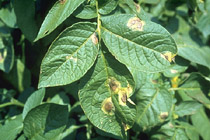 |
| Lesions of late blight caused by Phytophthora infestans on potato leaves. |
Late blight of potato, caused by a fungus called Phytophthora infestans, remains to this day a very serious disease that can cost potato growers attempting to control its presence many thousands of dollars each season. Late blight is often noted as being responsible for the Irish potato famine in 1845. It also caused severe epidemics in Great Britain, Holland and Belgium during the same years it caused the Irish potato famine. Many families in the US emigrated to the US during the years in which this famine was at its peak.
|
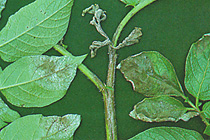
|
|
|
Lesions of late blight on leaves and stems of potato. The white areas are areas on which the fungus is sporulating. |
|
The disease made headlines in the US much more recently when new strains of this fungus caused epidemics in the US which were very difficult to bring under control. The new strains were resistant to previously effective fungicides which were consequently no longer effective. During the nineteenth and early twentieth centuries scientists had collected samples of infected potato and tomato plants all over the world. These samples were carefully preserved in herbariums. The earliest collections are from 1842 and 1846 coinciding with the Irish famine.
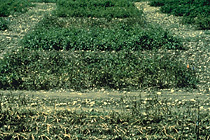 |
|
| Potato plots showing different levels of destruction by Phytophthora infestans. The most severely infected plants are killed by infection. |
|
|
|
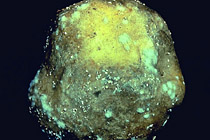 |
|
Phytophthora infestans also infects potato tubers causing rot and complete loss of the tuber.
|
|
Recently, three scientists at North Carolina State University, J. Ristaino, C. Groves and G. Parra, examined these musty old herbarium collections using modern DNA technologies in an effort to confirm the identity of the pathogen and its relationship to genotypes now found in the world.
The authors not only were able to isolate the DNA from samples collected in 1845 and 1847 but used that DNA to confirm that the agent responsible for the epidemics during that time was in fact P. infestans. Furthermore, by using specific fragments (pieces) of the DNA from these samples, the authors suggest that the US-1 clonal lineage of the fungus which dominated the population of the fungus world wide before the 1980's was not solely responsible for the epidemics during the Irish famine and later in the epidemics in the 19th and 20th centuries. Previously, most plant pathologists had believed that US-1 was a direct descendant of the fungus that caused the Irish potato famine.
For additional information, see the report authored by J.B. Ristaino, C. T. Groves and G.R. Parra, entitled, "PCR amplification of the Irish potato famine pathogen from historic specimens", reported in Nature Volume 411 on page 695.
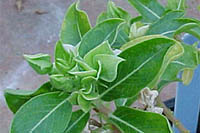 |
Views: Aster Yellows.
Aster Yellows is a disease caused by a phytoplasma. Phytoplasmas, like bacteria, are prokaryotes (have no nucleus), but lack cell walls and are difficult to culture in laboratories. Aster Yellows phytoplasma can be transmitted from plant to plant through grafting and by insects called leafhoppers, but not by touching. Click image for an larger view, more information |
